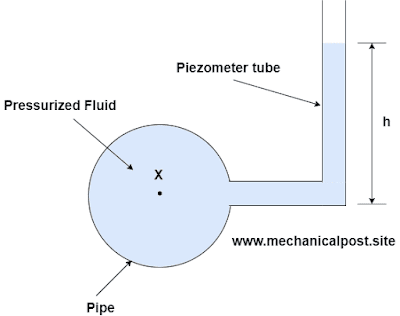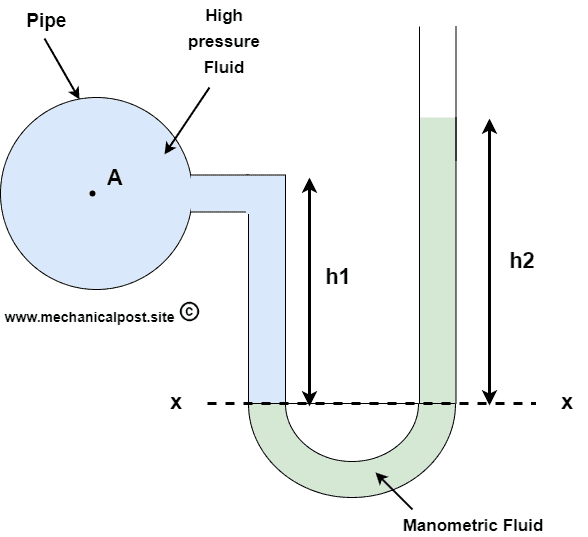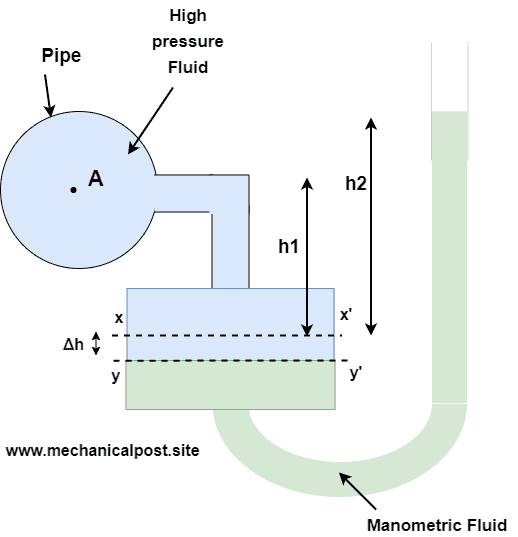What is manometer? types,uses and advantages |The Mechanical post
This is The mechanical post and today we’ll be looking at what is a manometer? its types, applications, advantages, and disadvantages.
Get your Free PDF copy of Manometer at the end of this article. Let us begin by understanding What is a manometer?.

What is a Manometer?
A U tube manometer is a type of pressure measuring device which measures the pressure of a fluid by balancing the levels of fluid in the 2 columns of its U-shaped tube.
Types of manometer
Manometers are broadly classified as follows :
- Simple manometers
- Piezometer
- U-tube manometer
- Single column manometer ( micrometer )
- Differential manometers
- U-tube differential manometer.
- Inverted U-tube differential manometer.
In this article, we will see in detail about simple manometers only. We have a separate & detailed article on differential manometers and their types.
Before starting let us get acquainted with the terms “gauge pressure” and “absolute pressure”
Gauge pressure:-
When the pressure is measured above the normal atmospheric pressure as reference it is called as positive gauge pressure
Absolute pressure:-
When the pressure is measured from absolute zero or complete vacuum it is known as absolute pressure.
Let’s start with simple manometers.
Piezometer tube
The piezometer tube is one of the simplest types of manometer. It consists of a glass tube of small diameter in the shape of the letter “L”.
One end of the tube is connected to the source whose pressure is to be measured (for e.g.- a pipeline) while the other end is kept open to the atmosphere as shown below:
Working of Piezometer tube:- When a pressurized liquid flows through the pipeline, it enters the piezometer. Due to the pressure, the liquid level starts to rise.
At a certain point, when the pressure is balanced on both sides the liquid comes to rest. This rise in the level of the liquid in the tube is denoted by “h”.
For pressure (P) at point X
P = w*h
Where,
P = pressure of the liquid in N/m2.
w = specific weight of liquid in N/m3.
h = length of rising liquid level in meters.
Advantages of Piezomoter tube
The following are the advantages of piezometer tube
- The Piezometer tube has a simple construction.
- It is inexpensive.
- Can be easily replaced.
- The piezometer is suitable for low and medium gauge pressure.
Disadvantages of Piezomoter tube
The following are the disadvantages of piezometer tube
- Piezometer tube can measure gauge pressure only.
- It cannot be used for high-pressure measurements.
- Only the pressure of liquids can be measured.
You might also like to read:
Simple U-tube manometer
The Simple U tube manometer is a small glass tube in the shape of “U” with readings marked on it.
The U-shaped glass tube has a diameter of 10 to 12mm, whose one end is connected to the source whose pressure is to be measured, while the other end is open to the atmosphere as shown in the figure
The U-tube manometer is filled with a liquid whose specific gravity is more than the specific gravity of the liquid whose pressure is to be measured.
This heavy liquid filled in the manometer is known as a manometric liquid. Usually, mercury ( Hg ) is used as a manometric fluid.
Working of U-Tube Manometer
When the pressurized fluid flows through the pipeline, it enters the U-tube manometer. This liquid exerts pressure on the manometric fluid.
This causes the manometric fluid to rise in the right limb. However, as the manometric liquid is heavier it rises slowly as compared to the liquid in the pipeline.
Let us consider,
h1 = height of liquid in left limb above the datum X-X
h2 = height of liquid in right limb above datum X-X
h = pressure heat at point A in terms of meters of water
s1 = specific gravity of the liquid in the pipe
s2 = specific gravity of heat liquid
According to pascal’s law, pressure in the left limb must be equal to the pressure in the right limb.
Pressure in left limb above X-X = Pressure in right limb above X-X.
h + s1*h1 = s2*h2.h = ( s2*h2 - s1*h1) m of water
Thus, we get the pressure of the liquid flowing in the pipeline in terms of pressure head in terms of meters of water.
To measure negative pressure (suction),
Pressure in the left limb above X-X = Pressure in the right limb above X-X
h + s1*h1 + s2*h2 = 0 ( since there is no liquid )
Advantages of U- tube manometer :
The following are the advantages of the U tube manometer.
- U tube manometer has a simple construction.
- It is inexpensive in cost and working.
- Accurate readings.
- Pressure readings can be easily calculated.
Disadvantages of U tube manometer :
The following are the disadvantages of the U-tube manometer.
- U tube manometer cannot be used for high-pressure measurement as there is a possibility of the liquid overflowing from the tube.
- As the right limb of the U tube manometer is exposed to the atmosphere there is a chance of foreign particles entering the manometer.
- It cannot detect small changes in pressure.
Vertical single column manometer or micromanometer
The Micromanometer is a modified form of a U-tube manometer. A reservoir having a larger cross-sectional area is connected to one area of the left limb of the manometer as shown in the figure.
Due to the large cross-sectional area of the reservoir, for any variation in pressure, the change in the liquid level in the reservoir will be very small and is negligible.
Therefore the pressure is given by the height of the liquid in the right limb.
As shown in the figure vertical single-column manometer is connected to a pipe containing light liquid under higher pressure.
The pressure of the liquid in a pipe forces the manometric liquid downwards in the reservoir. Due to the large area of the reservoir, the fall of manometric liquid level will be very small.
This downward movement of manometric liquid in the reservoir will cause a rise of manometric liquid in the right limb.
Let,
h1 = Height of light liquid in the left limb above the datum AB.
h2 = Height of heavy liquid in right limb above the datum AB.
h = Pressure head of light liquid in a pipe.
s1 and s2 = Specific gravity of light liquid in a pipe and heavy liquid in right limb.
Δh = Fall of heavy liquid level in the reservoir. The pressure at the point ‘X’ in a pipe is given by,
h = (a*h2/A ) (s2 - s1 ) + (s2*h2 - s1*h1)
here,
a = Cross-sectional area of the right limb.
A = cross-sectional area of the reservoir.
But, area A is too large as compared to area ‘a’. Hence the ratio a/A is negligible.
Advantages of miromanometer :
The following are the advantages of a micro manometer.
- A micromanometer is highly sensitive.
- Increased accuracy in pressure measurement.
- It can measure low pressure with high accuracy.
Disadvantages of micromanometer :
The following are the disadvantages of a micro manometer.
- is expensive as compared to a U-tube manometer.
- Although it can measure pressure with high accuracy it loses against Bourdon tube gauge in pressure measurement.
Check out this video for a better understanding.
Image Credits:
All the above images are the copyright of The Mechanical post. You are free to use the images with proper attribution to The Mechanical post under the Attribution-ShareAlike 3.0 Unported (CC BY-SA 3.0) license.
If you like this post or have any suggestions do let us know in the comments we would love to hear from you.
Also, share this post with friends and family with the social links provided below.








“The explanation of the U-tube manometer in this article about manometers was incredibly helpful! Now I understand its significance in measuring pressure. Great content!”
Thank you, Ashlyn! I’m glad you found the information about U-tube manometers helpful.
As someone new to the subject of manometers, I really appreciated the detailed explanation of U-tube manometers in this article.
I’m delighted that the article explained it well for you. If you have any other questions or need further clarification, feel free to ask!
I’m a bit confused about the difference between absolute pressure and gauge pressure. Can someone please explain?
Sure! Absolute pressure is the total pressure at a given point, including atmospheric pressure. Gauge pressure, on the other hand, only measures the pressure above atmospheric pressure. So, gauge pressure = absolute pressure – atmospheric pressure.
I had a doubt, What is the unit of measurement used for pressure in manometers?
Good question Neil, The unit of measurement used for pressure in manometers is usually expressed in “inches of water column” (inH2O) or “millimeters of mercury” (mmHg).
I was researching manometers for a project, and I must say, this article nailed it!
It’s great to hear that the article helped you! Wishing the best for your project 👍